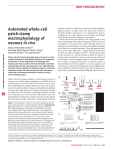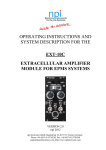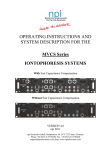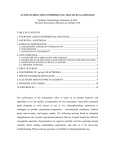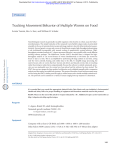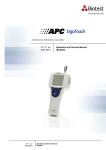Download ELC-01MX manual ver2_6 - NPI Electronic Instruments
Transcript
OPERATING INSTRUCTIONS AND SYSTEM DESCRIPTION FOR THE ELC-01MX ELC AMPLIFIER MODULE for EXTRA & INTRACELLULAR RECORDING, SINGLE CELL STIMULATION and ELECTROPORATION VERSION 2.6 npi 2015 npi electronic GmbH, Bauhofring 16, D-71732 Tamm, Germany Phone +49 (0)7141-9730230; Fax: +49 (0)7141-9730240 [email protected]; http://www.npielectronic.com ELC-01MX User Manual Table of Contents 1 Safety Regulations .............................................................................................................. 3 2 EPMS-07 Modular Plug-In System .................................................................................... 4 2.1 General System Description / Operation ..................................................................... 4 2.2 EPMS-07 Housing ....................................................................................................... 4 2.3 EPMS-H-07 Housing................................................................................................... 4 2.4 EPMS-E-07 Housing ................................................................................................... 4 2.5 EPMS-03 ..................................................................................................................... 5 2.6 PWR-03D .................................................................................................................... 5 2.7 System Grounding ....................................................................................................... 6 2.7.1 EPMS-07/EPMS-03 ...................................................................................... 6 2.7.2 EPMS-E-07 ................................................................................................... 6 2.8 Technical Data ............................................................................................................. 6 2.8.1 EPMS-07, EPMS-E-07 and EPMS-H-07 ..................................................... 6 2.8.2 EPMS-07 and EPMS-H-07 ........................................................................... 6 2.8.3 EPMS-E-07 ................................................................................................... 6 2.8.4 EPMS-03 ....................................................................................................... 6 3 Rationale ............................................................................................................................. 7 4 ELC-01MX ......................................................................................................................... 9 4.1 ELC-01MX Components ............................................................................................. 9 4.2 Optional Accessories ................................................................................................... 9 4.3 System Description ...................................................................................................... 9 4.3.1 Operation modes of the amplifier ................................................................. 9 4.3.2 Input configuration:....................................................................................... 10 4.3.3 Computer control of the mode of operation .................................................. 10 4.3.4 Output configuration ..................................................................................... 10 4.3.5 Digital displays ............................................................................................. 10 4.4 Description of the Front Panel ..................................................................................... 11 5 Headstage ............................................................................................................................ 16 5.1 Headstage Elements ..................................................................................................... 17 5.2 Headstage Bias Current Adjustment ............................................................................ 18 6 Passive Cell Model ............................................................................................................. 19 6.1 Cell Model Description ............................................................................................... 19 6.2 Connections and Operation ......................................................................................... 20 7 Introduction into Experiments ............................................................................................ 22 7.1 Recordings with the Differential Headstage (optional) ............................................... 22 7.2 Extracellular Voltage Measurement ............................................................................ 23 7.3 Extracellular Stimulation and Electroporation ............................................................ 24 7.3.1 Stimulation with Current .............................................................................. 24 7.3.2 Electroporation with Current ........................................................................ 24 7.3.3 Stimulation with Voltage .............................................................................. 24 7.3.4 Electroporation with Voltage ........................................................................ 24 7.4 Intracellular Recording ................................................................................................ 25 7.4.1 Current Clamp Recording ............................................................................. 25 7.4.2 Voltage Clamp Recording............................................................................. 25 8 Literature ............................................................................................................................. 26 9 Technical Data .................................................................................................................... 30 version 2.6 page 2 ELC-01MX User Manual 1 Safety Regulations VERY IMPORTANT: Instruments and components supplied by npi electronic are NOT intended for clinical use or medical purposes (e.g. for diagnosis or treatment of humans), or for any other life-supporting system. npi electronic disclaims any warranties for such purpose. Equipment supplied by npi electronic must be operated only by selected, trained and adequately instructed personnel. For details please consult the GENERAL TERMS OF DELIVERY AND CONDITIONS OF BUSINESS of npi electronic, D-71732 Tamm, Germany. 1) GENERAL: This system is designed for use in scientific laboratories and must be operated by trained staff only. General safety regulations for operating electrical devices should be followed. 2) AC MAINS CONNECTION: While working with the npi systems, always adhere to the appropriate safety measures for handling electronic devices. Before using any device please read manuals and instructions carefully. The device is to be operated only at 115/230 Volt 60/50 Hz AC. Please check for appropriate line voltage before connecting any system to mains. Always use a three-wire line cord and a mains power-plug with a protection contact connected to ground (protective earth). Before opening the cabinet, unplug the instrument. Unplug the instrument when replacing the fuse or changing line voltage. Replace fuse only with an appropriate specified type. 3) STATIC ELECTRICITY: Electronic equipment is sensitive to static discharges. Some devices such as sensor inputs are equipped with very sensitive FET amplifiers, which can be damaged by electrostatic charge and must therefore be handled with care. Electrostatic discharge can be avoided by touching a grounded metal surface when changing or adjusting sensors. Always turn power off when adding or removing modules, connecting or disconnecting sensors, headstages or other components from the instrument or 19” cabinet. 4) TEMPERATURE DRIFT / WARM-UP TIME: All analog electronic systems are sensitive to temperature changes. Therefore, all electronic instruments containing analog circuits should be used only in a warmed-up condition (i.e. after internal temperature has reached steady-state values). In most cases a warm-up period of 20-30 minutes is sufficient. 5) HANDLING: Please protect the device from moisture, heat, radiation and corrosive chemicals. version 2.6 page 3 ELC-01MX User Manual 2 EPMS-07 Modular Plug-In System 2.1 General System Description / Operation The npi EPMS-07 is a modular system for processing of bioelectrical signals in electrophysiology. The system is housed in a 19” rack-mount cabinet (3U) has room for up to 7 plug-in units. The plug-in units are connected to power by a bus at the rear panel. The plug-in units must be kept in position by four screws (M 2,5 x 10). The screws are important not only for mechanical stability but also for proper electrical connection to the system housing. Free area must be protected with covers. 2.2 EPMS-07 Housing The following items are shipped with the EPMS-07 housing: ✓ ✓ ✓ ✓ EPMS-07 cabinet with built-in power supply Mains cord Fuse 2 A / 1 A, slow (inserted) Front covers Figure 1: Left: front view of empty EPMS-07 housing. In order to avoid induction of electromagnetic noise the power supply unit, the power switch and the fuse are located at the rear of the housing (see Figure 2, right). 2.3 EPMS-H-07 Housing In addition to the standard power supply of the EPMS-07, the EPMS-H-07 has a built-in high voltage power supply. This is necessary for all MVCS / MVCC modules, the HVA-100, HVTR150 and HVC-03M modules. The output voltage depends on the modules in use. 2.4 EPMS-E-07 Housing The following items are shipped with the EPMS-E-07 housing: ✓ ✓ ✓ ✓ ✓ ✓ EPMS-E-07 cabinet External Power supply PWR-03D Power cord (PWR-03D to EPMS-E-07) Mains chord Fuse 1.6 A / 0.8 A, slow (inserted) Front covers version 2.6 page 4 ELC-01MX User Manual The EPMS-E-07 housing is designed for low-noise operation, especially for extracellular and multi-channel amplifiers with plugged in filters. It operates with an external power supply to minimize distortions of the signals caused by the power supply. 2.5 EPMS-03 The following items are shipped with the EPMS-03 housing: ✓ ✓ ✓ ✓ EPMS-03 cabinet with built-in power supply Mains cord Fuse 034 A / 0,2 A, slow (inserted) Front covers Figure 2: Left: front view of EPMS-03 housing. Right: rear panel detail of EPMS-03 and EPMS-07 housing. In order to avoid induction of electromagnetic noise the power supply unit, the power switch and the fuse are located at the rear of the housing (see Figure 2, right). 2.6 PWR-03D The external power supply PWR-03D is capable of driving up to 3 EPMS-E housings. Each housing is connected by a 6-pole cable from one of three connectors on the front panel of the PWR-03D to the rear panel of the respective EPMS-E housing. (see Figure 3, Figure 4). A POWER LED indicates that the PWR-03D is powered on (see Figure 3, left). Power switch, voltage selector and fuse are located at the rear panel (see Figure 3, right). Note: The chassis of the PWR-03D is connected to protective earth, and it provides protective earth to the EPMS-E housing if connected. Figure 3: Left: PWR-03D front panel view Right: PWR-03D rear panel view. Note: This power supply is intended to be used with npi EPMS-E systems only. version 2.6 page 5 ELC-01MX User Manual 2.7 2.7.1 System Grounding EPMS-07/EPMS-03 The 19" cabinet is grounded by the power cable through the ground pin of the mains connector (= protective earth). In order to avoid ground loops the internal ground is isolated from the protective earth. The internal ground is used on the BNC connectors or GROUND plugs of the modules that are inserted into the EPMS-07 housing. The internal ground and mains ground (= protective earth) can be connected by a wire using the ground plugs on the rear panel of the instrument. It is not possible to predict whether measurements will be less or more noisy with the internal ground and mains ground connected. We recommend that you try both arrangements to determine the best configuration. 2.7.2 EPMS-E-07 The 19" cabinet is connected to the CHASSIS connector at the rear panel. It can be connected to the SYSTEM GROUND (SIGNAL GROUND) on the rear panel of the instrument (see Figure 4). The chassis can be linked to PROTECTIVE EARTH by connecting it to the PWR-03D with the supplied 6-pole cable and by interconnecting the GROUND and PROTECTIVE EARTH connectors on the rear panel of the PWR-03D (see Figure 3). Best performance is generally achieved without connection of the chassis to protective earth. Important: Always adhere to the appropriate safety measures. Figure 4: Rear panel connectors of the EPMS-E-07 2.8 Technical Data 2.8.1 EPMS-07, EPMS-E-07 and EPMS-H-07 19” rack-mount cabinet, for up to 7 plug-in units Dimensions: 3U high (1U=1 3/4” = 44.45 mm), 254 mm deep 2.8.2 EPMS-07 and EPMS-H-07 Power supply: 115/230 V AC, 60/50 Hz, fuse 2 A / 1 A slow, 45-60 W 2.8.3 EPMS-E-07 External power supply (PWR-03D) 115/230 V AC, 60/50 Hz, fuse 1.6/0.8 A, slow Dimensions of external power supply: (W x D x H) 225 mm x 210 mm x 85 mm 2.8.4 EPMS-03 Power supply: 115/230 Volts AC, 60/50 Hz, fuse 0.4 A / 0.2 A slow Maximum current supply: 500 mA Dimensions: 3U high (1U=1 3/4” = 44.45 mm), 254 mm deep, 265 mm wide version 2.6 page 6 ELC-01MX User Manual 3 Rationale “Loose patch” recordings (or “loose seal” recordings [Roberts & Almers, 1992]) are used to record from single excitable cells without damage, i.e. without a direct access to the cell interior. This technique was described in a seminal paper, “A method has been developed permitting measurement of membrane impedance and current, as a function of transmembrane potential, at small, electrically isolated regions of the muscle cell surface without microelectrode impalement.”[Strickholm 1961], twenty years before the introduction of “tight seal recording” by Neher and Sakmann [Review in Sakmann & Neher 1995]. The loose seal has a resistance of a few ten to a few hundred MΩ, and it creates an electrically isolated access to a single neuron. This isolated area can be used for precise recording, stimulation, or drug and dye application on the single-cell level without damaging the cell [Babour & Isope, 2000]. In contrast to tight seal recordings, this technique has the great advantage that the same electrode can be reused for recording from several cells. Since its beginnings, several attempts have been made to make such precise extracellular methods accessible to various preparations. An excellent overview can be found in the chapter by Roberts & Almers [Roberts & Almers, 1992]. Over the years the method was extended to cultured neurons and brain slice preparations, and also for in vivo recordings [Bureau et al, 2004], Sakmann, 2006]. The method is particularly well suited for long term recording with little damage to the recorded neuron [Nunemaker et al, 2003]. It can be used both for somatic and axonal recording [Khaliq & Raman, 2005]. Even subcellular structures such as synaptic boutons are accessible to loose patch recordings [Auger & Marty, 2000]. Another valuable application of this method is single-cell stimulation. The high resistance loose patch allows the application of 1-2 V stimuli to only one cell [Babour & Isope, 2000]. In the nineties of the last century the method of juxtacellular dye application (juxtasomal filling) became popular [Pinault, 1996]. This staining method is based on repetitive current pulse trains applied in the close vicinity of cell somata or dendrites, and has now become well established in the field of slice and in vivo preparations [Klausberger, 2004, Duque, A and L. Zaborszky 2006, Pinault, 2011]. In parallel, attempts were made towards transfection of single cells by electroporation using patch pipettes. DNA or other large molecules were successfully inserted through a patch pipette into living cells by using an optimized protocol (application of 10 V / 1 ms pulse trains) [Rathenberg et al, 2003, Stan et al 2010]. Another significant advance from classical in vivo recording methods [such as Lalley et al, 1999] is the use of this method in novel applications under in vivo conditions. An excellent example of these kinds of technological advances are the studies of Helmchen and Stosiek [Helmchen et al, 2002; Stosiek et al, 2003; Brecht et al, 2002, Nevian & Helmchen 2007], which used patch clamp recording together with two-photon microscopy. Assays have also been developed that enable both monitoring and manipulation of single cells under in vivo conditions [Brecht et al, 2004]. Besides sophisticated optics, these techniques always require precise recording and stimulation amplifiers that usually must work with patch electrodes. High resolution in vivo recordings with ELC amplifiers are meanwhile a standard in many labs [Geis et al, 2011, Resinger et al 2011], and by using miniature headstages recordings from free moving animals are possible [Epsztein et al, 2011]. version 2.6 page 7 ELC-01MX User Manual Today three methods are used to record electrically in vivo or in vitro: ❏ Recordings using patch (suction) electrode from single neurons ❏ Whole-cell patch clamp technique (tight seal recording, intracellular) ❏ Loose patch technique (loose seal recording, extracellular) ❏ Intracellular recordings with sharp microelectrodes ❏ Extracellular recordings with glass or metal electrodes The amplifiers normally used for these types of measurements are specialized for the recording of the potentials or currents generated by the neurons under investigation. If these recording methods are combined with dye injection, electroporation, stimulation or other electrical techniques that require multiple use of the recording electrode, additional constraints are imposed on the experimental setup that may require the acquisition of additional components. The ELC series of amplifiers fills this gap. It allows intracellular, extracellular, voltage-clamp or current clamp recordings both with sharp or patch electrodes as well as additional protocols like electroporation or juxtasomal filling and amperometry / voltammetry methods. The ELC amplifier is the “Swiss Army Knife” of modern electrophysiology. It is not only easy to use, but it is also sufficiently versatile to enable the use of a single amplifier for many sophisticated experiments. version 2.6 page 8 ELC-01MX User Manual 4 ELC-01MX 4.1 ELC-01MX Components The following items are shipped with the ELC-01MX system: ✓ ✓ ✓ ✓ 4.2 o o o o 4.3 Amplifier module for the EPMS-07 system GND (2.6 mm banana plug) and (optional) REF. (SMB) connectors for headstage Headstage User manual Optional Accessories Differential headstage Miniature headstage Cell model Pipette holder System Description The ELC-01MX was designed for intra- and extracellular recording, precise (single cell) electrical stimulation as well as juxtasomal filling with patch electrodes. The system consists of a module for the npi EPMS-07 modular system and a small headstage with holding bar, dovetail or a mounting plate. It can be used in slices or in in vivo preparations using the optional headstage with a differential input or for recordings in free moving animals using a miniature headstage. It has separate capacity compensation controls for VC and CC mode, all controls (Bridge balance, CC cap comp, offset, holding controls) are calibrated 10-turn potentiometers. The ELC-01MX is capable to record extracellularly DC or AC coupled, to stimulate with current or voltage and to perform non-invasive juxtasomal filling of cells with dyes or DNA. The amplifier can also be used to record and stimulate intracellularly in current clamp (CC) or voltage clamp (VC). It is also suitable for amperometric or voltammetric investigations with carbon fiber electrodes. 4.3.1 Operation modes of the amplifier The operation modes of the amplifier are selected by a rotary switch with five positions: The selected mode is indicated by LEDs above the two digital displays. EXT: CC OFF: VC VCx10 version 2.6 VC or CC are selected by a TTL pulse applied to the MODE SELECT BNC CURRENT CLAMP MODE: used to inject current signals CC Mode with all input signals turned off VOLTAGE CLAMP mode: potential commands are applied to the electrode High-range VC mode: for stimulation and electroporation page 9 ELC-01MX User Manual In addition, using a toggle switch a bridge balance circuit can be activated to compensate for the electrode artifact (BRIDGE mode, only in CC mode). With the same switch the ELECTRODE RESISTANCE test mode is activated. The electrode resistance is measured directly in MΩ and displayed on the POTENTIAL display. 4.3.2 Input configuration: The amplifier has two inputs for VC and CC mode. The signal applied to the analog input BNCs is converted either into a voltage command signal (x1 or x10 scaling) for the VC or VCx10 voltage clamp modes, or to a current in the CC and BRIDGE mode. Besides this, a signal generated from the 10-turn HOLD potentiometer can be transferred into a pulse using the GATE TTL input BNC. This control can be also used as HOLDING potentiometer if the switch in the GATE BNC is turned off. 4.3.3 Computer control of the mode of operation In the EXT position of the MODE OF OPERATION switch the amplifier can be controlled by a TTL signal connected to the MODE SELECT BNC (LO = CC, HI = VC). 4.3.4 Output configuration The ELC-01MX amplifier has two output BNC connectors for POTENTIAL and one output BNC for the CURRENT signal. The POTENTIAL OUTPUT x1 is a pure DC output that monitors the electrode potential. The signal at the FILTERED OUTPUT can be high-pass filtered (6 corner frequencies), amplified (x10/x100/x1000) and filtered by a 3 kHz low-pass filter. The current output signal is amplified (x1/x10/x100) and also passed through a 3 kHz lowpass filter. All filters can be bypassed. 4.3.5 Digital displays All ELC amplifiers are equipped with two digital displays, one for CURRENT (nA) and one for POTENTIAL (mV) or ELECTRODE RESISTANCE (MΩ). The mode of operation is indicated by a row of LEDs located close to the digital displays. version 2.6 page 10 ELC-01MX User Manual 4.4 Description of the Front Panel Figure 5: ELC-01MX front panel view In the following description of the front panel elements each element has a number that is related to that in Figure 5. The number is followed by the name (in uppercase letters) written on the front panel and the type of the element (in lowercase letters). Then, a short description of the element is given. Some elements are grouped in functional units (e.g. extracellular recording unit) and are described as units regardless of the order of numbers. (1) CURRENT (nA) display Display showing the current flowing through the electrode in XX.XX nA (max 19.99 nA). version 2.6 page 11 ELC-01MX User Manual (2) PIP. HOLD / OFFSET potentiometer Control to compensate for the electrode potential OFFSET (ten-turn potentiometer, symmetrical, i.e. 0 mV = 5 on the dial) in CC mode (range: ±100 mV), or to zero the pipette current in VC mode. In CC mode any offset caused by electrode (tip potential, liquid junction potential etc.) is cancelled by subtracting this potential value from the electrode, i.e. an offset of –10 mV is cancelled by subtracting -10 mV using this potentiometer. In VC mode an offset at the electrode would lead to current flow through the electrode because without a COMMAND the electrode will be clamped to 0 mV, and the VC circuit generates a current to achieve this. In order to avoid this current flow the electrode has to be clamped to its offset potential, i.e. a potential has to be added to the COMMAND. In the scenario mentioned above the electrode has to be clamped to –10 mV. Then, the electrode is clamped to its offset potential and no current will flow. If the OFFSET is correctly compensated in CC mode, there is automatically no current flow when approaching the cell in VC mode. However, liquid junction potentials occurring after establishing the whole-cell configuration are not automatically cancelled. Important: Command potentials are not affected. Potential out shows zero! Note: This procedure has to be done at the beginning of the experiment as soon as the pipette has contact to the bath solution, i.e. before approaching a cell. (3) CUR. OUTP. SENSITIVITY switch Switch to select the scaling of the CURRENT OUTPUT 0.1 1 10 0.1 V/nA (1 V = 10 nA) 1 V/nA (1V = 1 nA) 10 V/nA (1 V = 0.1 nA) (4) HOLD. CUR. (nA) potentiometer Ten-turn potentiometer for generating a holding current in CC or BRIDGE mode, or for setting the amplitude of the GATED stimulus (see also #9), range: ±100 nA (100 = 10 nA). (5) HOLD. CUR. (nA) polarity switch Switch for setting the polarity of the holding current in CC or BRIDGE mode, or for the GATED stimulus (see also #9). In zero position the holding current/gated stimulus is disabled. (6) C.COMP. potentiometer Ten-turn potentiometer for compensating the capacity of the electrode, clockwise, range: 0-30 pF. Functional in all current clamp modes (CC, CC+ BRIDGE, REL, OFF) (7) STIM. INPUT 10 nA/V connector BNC connector for an external command in CC or BRIDGE mode (sensitivity: 10 nA / V, i.e. 1 V = 10 nA). The voltage signal that is connected here is transformed to a proportional current at the electrode in CC mode. The signal form remains unchanged. version 2.6 page 12 ELC-01MX User Manual (8) MODE SELECT (TTL) connector BNC connector for remote control of the MODE of operation. The TTL signal connected here selects the mode of operation remotely (HI = VC, LO = CC); functional in EXT mode only. (9) GATE connector / ON switch BNC connector for generating a stimulus with a TTL signal in CC, VC or VCx10 mode. A current or a voltage stimulus respectively is applied to the electrode as long as the TTL signal connected here is HI, and the ON switch is set to the upper position (ON). The amplitude of the stimulus is set by the HOLD. CUR. (nA) potentiometer (#4) in CC mode or the HOLD. POT. (mV) potentiometer (#18) in VC mode. The polarity of the stimulus is set by the HOLD. CUR. (nA) polarity switch (#5). Setting the ON switch to the lower position disables the GATED stimulus, and enables the setting of a holding current in CC or BRIDGE mode or a holding potential in VC or VCx10 mode. (10) CURRENT OUTPUT connector / LP FILTER ON switch BNC connector providing the current flowing through the electrode in nA / V. The scaling is dependent on the setting of the CUR. OUTP. SENSITIVITY switch (#3). Setting the LP FILTER ON switch to the upper position (ON) enables the built-in low-pass filter (corner frequency: 3 kHz, attenuation: -18 dB/octave), i.e. the CURRENT OUTPUT connector provides the filtered current with the scaling set by switch #3. In the lower position, the built-in low-pass filter is disabled, i.e. the CURRENT OUTPUT connector provides the unfiltered current with the scaling set by switch #3. (11) POTENTIAL OUTPUT connector / LP FILTER ON switch BNC connector providing the potential at the electrode in mV. The scaling is dependent on the setting of the POT. OUTP. SENSITIVITY switch (#21). Setting the LP FILTER ON switch to the upper position (ON) enables the built-in low-pass filter (corner frequency: 3 kHz, attenuation: -18 dB/octave), i.e. the POTENTIAL OUTPUT connector provides the filtered potential with the scaling set by switch #21. In the lower position, the built-in low-pass filter is disabled, i.e. the POTENTIAL OUTPUT connector provides the unfiltered current with the scaling set by switch #21. (12) BUZZ push button Push button to activate the BUZZ circuit. In order to facilitate the penetration of the cell membrane or to clean the tip of the electrode a BUZZ circuit is provided which is based on oscillations caused by overcompensating the capacitance compensation system. The overcompensation of capacitance compensation yields very powerful high-frequency oscillations. The BUZZ circuit is active as long as the button is pressed. (13) POTENTIAL OUTPUT x1 connector BNC connector providing the potential at the electrode in V. The scaling is fixed to x1 and therefore independent on the setting of the POT. OUTP. SENSITIVITY switch (#20). This connector is normally used to monitor voltage pulses in the VCx10 mode (see also #23), or else to provide a DC signal if the high-pass filter (#19, Figure 5) is used. version 2.6 page 13 ELC-01MX User Manual (14) COMM. INP. ÷10 mV connector Please see below (Voltage Clamp Unit) (15) HEADSTAGE connector Connector to attach the HEADSTAGE via a flexible cable. Voltage Clamp Unit The voltage clamp unit consists of (14) COMM. INP. /10 mV connector, (16, 17) AMPL and T.CONST. trim-pots, (18) HOLD. POT. (mV) switch and (19) HOLD. POT. (mV) potentiometer. (14) COMM. INP. ÷10 mV connector BNC connector for an external command in VC mode (sensitivity: ÷10 mV, i.e. 100 mV signal at this connector generates a command of 10 mV) or in VCx10 mode (sensitivity: x1 mV, i.e. 100 mV signal at this connector generates a command of 100 mV). The signal form remains unchanged. (16) AMPL. trim-pot / T.CONST. trim-pot Trim-pots for compensating for the electrode capacity in VC mode. A square shaped command pulse in VC will be distorted by the electrode capacity. The shape of the command can be influenced by these trim-pots in order to get the command pulse as square as possible. AMPL. trim-pot: Trim-pot for setting τ-FAST in the electrode capacity compensation circuit. T.CONST. trim-pot: Trim-pot for setting C-FAST in the electrode capacity compensation circuit. Note: CAPACITY COMPENSATION works only for the electrode capacity, not for the capacity of the cell membrane. Therefore, capacitive transients of the cell are always present when square shaped pulses are applied in VC mode. (17) HOLD. POT. (mV) switch Switch for setting the polarity of the holding potential in VC/VCx10 mode or for the GATED stimulus (see also #10). In zero position the holding potential/gated stimulus is disabled. (18) HOLD. POT. (mV) potentiometer Control for setting the amplitude of the continuous holding potential, or for setting the amplitude of the GATED stimulus (see also #10) in VC mode (range: ±1000 mV) or in VCx10 mode (range: ±10 V). In zero position the holding/gated potential is disabled. version 2.6 page 14 ELC-01MX User Manual Extracellular recording unit The extracellular recording unit consist of (20) HP FILTER (Hz) switch and (21) POT. OUTP. SENSITIVITY switch. Hint: Set the MODE OF OPERATION switch to OFF for extracellular low-noise recording. (19) HP FILTER (Hz) switch Switch for setting the corner frequency of the high-pass filter (attenuation: -6 dB/octave) in AC recording mode. DC Recordings are done by switching the HP FILTER (Hz) switch to DC. Hint: During AC recording, a DC signal is always provided at the POTENTIAL OUTPUT x1 BNC connector (#13). (20) POT. OUTP. SENSITIVITY switch Switch for scaling the POTENTIAL OUTPUT at the POTENTIAL OUTPUT connector (#11). Scaling factors: x10, x100, x1000. Important: The POT. OUTP. SENSITIVITY switch is only related to the POTENTIAL OUTPUT BNC (#11) and is always active, i.e. not only in extracellular recordings but also in CC, BRIDGE and VC/VCx10 mode. (21) REL / BRIDGE ON switch Switch for activation of either the electrode resistance test circuit (switch set to: REL) or the BRIDGE balance circuit (switch set to: BRIDGE ON) in CC mode. Both settings are indicated by LEDs (#26). The BRIDGE balance circuit compensates for the electrode artifact and allows accurate, intracellular measurements of the membrane potential und application of current stimuli. The BRIDGE is adjusted using the BR.BAL. potentiometer (#23). (22) BR.BAL. potentiometer If current is passed through the recording electrode in BRIDGE mode, the potential deflection caused at the electrode resistance is compensated with this control (ten turn potentiometer, clockwise, calibrated in MΩ, range: 100 MΩ, i.e. 100 = 10 MΩ). (23) MODE OF OPERATION switch 5-position rotary switch to set the MODE OF OPERATION. The following modes are possible: EXT: VC or CC are selected remotely by a TTL pulse (+5 V) applied to the MODE SELECT (TTL) connector (#8). HI (>1 V) selects VC, LO (<0.8 V) selects CC. CC Current Clamp mode, allows recording and stimulation in current clamp. The electrode artifact is not compensated unless the BRIDGE mode is activated and adjusted (see also #22 and #23). OFF: CC Mode with all input signals turned off. Can be used for extra- and intracellular recordings. REL is functional. VC VOLTAGE CLAMP mode, allows recording and stimulation in voltage (patch) clamp. Series resistance and τ-slow are not compensated. VCx10 High range VC mode (up to ±12 V), used for stimulation and electroporation version 2.6 page 15 ELC-01MX User Manual (24) POTENTIAL / RESISTANCE display Display showing the POTENTIAL at the electrode in XXXX mV or the electrode resistance in XXX MΩ (see also #22). (25) Status LEDs LEDs indicating the unit of the POTENTIAL / RESISTANCE display or the selected MODE OF OPERATION of the amplifier respectively. (26) BIAS trim-pot Trim potentiometer for adjusting the output BIAS current of the headstage (see also chapter 5.2). 5 Headstage The ELC-01MX comes with a headstage for connecting suction electrodes for loose-patch clamp or whole cell recordings and / or stimulation or electroporation, respectively, or sharp electrodes for extracellular or intracellular recordings. A differential headstage (see Optional accessories in chapter 4.2) or a miniature headstage for measurements in vivo is also available. For details contact npi. Figure 6: Headstage of the ELC-01MX version 2.6 page 16 ELC-01MX User Manual 5.1 • • • • • • • Headstage Elements PEL BNC connector for the electrode holder REF Connector for the reference electrode (differential headstage only) GND Ground connector TYPE Type of amplifier, BA Bridge amplifier, ELC ELC amplifier R FB Value of feedback resistor, 10M: 10 MΩ, 100 M: 100 MΩ Headstage cable to amplifier Mounting plate (holding bar or dovetail available on request) The electrode filled with electrolyte is inserted into an electrode holder (optional) that fits into the BNC connector of the headstage or into an electrode holder adapter. The electrical connection between the electrolyte and the headstage is established using a carefully chlorinated silver wire. Chlorinating of the silver wire is very important since contact of silver to the electrolyte leads to electrochemical potentials causing varying offset potentials at the electrode, deterioration of the voltage measurement etc. (for details see Kettenmann and Grantyn (1992)). An automated chlorinating apparatus (ACl-01) is available from npi for optimal chlorinating of sliver wires (please contact npi for details). Ground provides system ground and is linked to the bath via an agar-bridge or a Ag-AgCl pellet. The headstage is attached to the amplifier with the headstage cable (see Figure 6) and an 8-pole connector. The headstage is mounted to a insulated mounting plate that fits to most micromanipulators. A holding bar or dovetail is available on request. Note: The shield of the BNC connector is linked to the driven shield output and must not be connected to ground. The headstage enclosure is grounded. Caution: Please always adhere to the appropriate safety precautions (see chapter 1). Please turn power off when connecting or disconnecting the headstage from the HEADSTAGE connector! version 2.6 page 17 ELC-01MX User Manual 5.2 Headstage Bias Current Adjustment Caution: It is important that this tuning procedure is performed ONLY after a warm-up period of at least 30 minutes! The ELC-01MX is equipped with a voltage-to-current converter with a very high output impedance which is connected to the recording electrode. The zero current of this unit is tuned with the BIAS current trim-pot (see #26 in Figure 5). The tuning procedure should be performed regularly (about once a month) since the bias current changes over time. The tuning procedure is performed using high-value resistors and/or a cell model. It cannot be performed with an electrode, since there are always unknown potentials involved (tip potential, junction potentials). ❏ Disconnect all input signals (except the headstage). Put the holding current switch to position 0 (#5, Figure 5). Set the operation mode to CC. ❏ Connect the PEL connector of the headstage to ground. If oscillations occur take a resistor of a few kΩ and connect it to ground. Note: This cannot be done with the cell model. Please use a wire to connect the input of the BNC connector on the headstage to GND of the headstage. Do not use the shield of the BNC connector since it is connected to driven shield. ❏ Tune the OFFSET to zero using the OFFSET control (#2, Figure 5). Remember: The zero position of the OFFSET control is at 5!! ❏ Remove the wire and attach the cell model or a resistor with a value of about 10 MΩ across the same connection. ❏ The value displayed at the POTENTIAL DISPLAY is related to the BIAS current of the headstage according to Ohm's Law. Cancel this voltage by tuning the headstage BIAS current trim-pot (#27, Figure 5) until the POTENTIAL DISPLAY shows 000. version 2.6 page 18 ELC-01MX User Manual 6 Passive Cell Model The cell model is designed to be used to check the function of the instrument either 1. just after unpacking to see whether the instrument has been damaged during transport or 2. to train personnel in using the instrument or 3. in case of trouble to check which part of the setup does not work correctly, i. e. to find out whether the amplifier is broken or if something is wrong with the electrodes or holders etc. Figure 7: ELC-MOD passive cell model The passive cell model consists only of passive elements, i.e. resistors that simulate the resistance of the cell membrane and the electrodes, and capacitances that simulate the capacitance of the cell membrane. A switch allows simulation of two different cell types: a cell with 50 MΩ and 22 pF (CELL 1, represents an astrocyte like cell) or a cell with 200 MΩ membrane resistance and 100 pF membrane capacitance (CELL 2, represents an neuron like cell), or. Electrode immersed into the bath or SEAL formation can be mimicked as well. The headstage of the amplifier can be connected to one of two different types of electrodes (see below). 6.1 Cell Model Description Figure 8: ELC-MOD passive cell model version 2.6 page 19 ELC-01MX User Manual 1, 3: 2: 4: 5: connectors for the headstage, 1: electrode resistance: 50 MΩ, 3: electrode resistance: 10 MΩ GND ground connector, to be connected to GND jack of the headstage CELL: switch for cell membrane representing a membrane of either 50 MΩ and 22 pF (CELL 1) or 200 MΩ and 100 pF (CELL 2). In GROUND (lower) position the electrodes are connected to ground via a 1 kΩ resistor. In SEAL (upper) position are connected to a 1 GΩ resistor simulating the formation of a GIGASEAL with a patch electrode. Figure 9: Schematic diagram of the passive cell model 6.2 Connections and Operation Checking the configuration ❏ Turn POWER switch of the EPMS housing off. a) For simulation of an experiment using a patch pipette ❏ Connect the BNC jack labeled 10 MΩ of the cell model to the BNC connector PEL of the headstage. version 2.6 page 20 ELC-01MX User Manual b) For simulation of an experiment using a sharp electrode ❏ Connect the BNC jack labeled 50 MΩ of the cell model to the BNC connector PEL at the headstage. For a) and b) ❏ Connect GND of the cell model to GND of the headstage. Important: When using a differential headstage (optional) the REF connector at the headstage must not be left open. It must be connected to ground. Simulation of electrode in the bath ❏ Set switch #4, Figure 8 to the lower position. ❏ Set switch #5, Figure 8 to GROUND position. The 1 kΩ resistor simulates the resistance of the bath solution. This can be used to train cancellation of offsets, using the bridge balance and using the capacity compensation. Simulation of SEAL formation ❏ Set switch #4, Figure 8 to the lower position. ❏ Set switch #5, Figure 8 to SEAL position. The 1 GΩ resistor simulates the SEAL resistance when forming a GIGASEAL in patch clamp experiments. Simulation of intracellular recording Intracellular recordings can be mimicked with one of two cells with different properties. Use the 50 MΩ electrode connector (#1, Figure 8) for an experiment with sharp electrodes or the 10 MΩ electrode connector (#3, Figure 8) for simulating an experiment with patch electrodes. ❏ Switch the CELL membrane switch (see #4, Figure 8) to the desired position (CELL 1 or CELL 2). ❏ Turn all controls at the amplifier to low values (less than 1) and the OFFSET in the range of 5 (zero position) and the OSCILLATION SHUTOFF in the DISABLED position. ❏ Turn POWER switch of the EPMS housing on. Now you can adjust the amplifier (see below) and apply test pulses to the cell model. The upper position the CELL membrane switch (CELL 1) simulates a cell with a resistance of 50 MΩ and a capacitance of 22 pF. In the lower position (CELL 2) a cell membrane with 200 MΩ and 100 pF is simulated. version 2.6 page 21 ELC-01MX User Manual 7 Introduction into Experiments The ELC-01MX is capable to perform several types of experiments that are briefly introduced in the following. It is assumed that the capacity of the electrode is compensated, the offset of the electrode is cancelled and, for intracellular recordings in BRIDGE mode, electrode artifact is eliminated using the bridge balance circuit. 7.1 Recordings with the Differential Headstage (optional) Extracellular measurements are mostly done in slices or in vivo, in noisy environments, where distortions of the recorded signal caused by other instruments and the animal itself are very common. Additionally, extracellular signals are very small and have to be amplified enormously. The drawback is that noise is amplified as well. Therefore, the headstage of the ELC-01MX can be equipped with a differential input that minimizes noise pick-up. Differential means, that the signal for the amplifier is the difference between the positive (+) (PEL) and negative (-) (REF.) input of the headstage. This results in canceling of all common mode signals (i.e. which both electrodes record, e.g. noise). For differential measurements, both inputs of the headstage (REF. and PEL) are connected to microelectrodes using cables with grounded enclosure or electrode holders. PEL is connected to the measuring electrode and REF. to the reference electrode. The experimental chamber is grounded by an Ag-AgCl pellet (or an AGAR bridge) connected to GND of the headstage (see Figure 10). Important: For reliable measurements the experimental chamber or animal, respectively, must be grounded. Also Very Important: When operating in VC mode, the reference electrode must not have a resistance of more than 1 kΩ!! CC mode is not affected. If differential measurement is not required (single-ended measurement configuration, see Figure 10), the REF input must be connected to ground (GND). The amplifier is in an undefined state, if the REF is left open, and can go into saturation making reliable measurements impossible (for more details see Lalley et al., 1999). version 2.6 page 22 ELC-01MX User Manual Figure 10: headstage connections, A: differential measurement, B: single-ended measurement 7.2 Extracellular Voltage Measurement Extracellular measurements are usually done in a loose-patch configuration or with special metal microelectrodes. Recordings with extracellular metal electrodes is simple. The electrode is advanced in the region where the recordings will be made using a micromanipulator and the signals are filtered and amplified (see chapter 5 in Lalley et al., 1999 for details). For loose patch recording the procedure is the following (Barbour & Isope, 2000, Nunemaker et al, 2003): ❏ Approach the cell in VC mode and apply square voltage pulses to the electrode. ❏ Contact the cell and establish the loose-patch. ❏ Set the MODE OF OPERATION switch (#23, Figure 5) to OFF. ❏ Set the required amplification of the POTENTIAL OUTPUT using #20, Figure 5. ❏ Select DC or filtered AC coupling with switch #19, Figure 5. ❏ If needed apply the LP filter (3 kHz) to the output signal (see #11, Figure 5). version 2.6 page 23 ELC-01MX User Manual 7.3 Extracellular Stimulation and Electroporation Cells can be stimulated using current or voltage signals. 7.3.1 Stimulation with Current ❏ Approach the cell in VC mode and apply square voltage pulses to the electrode. ❏ Contact the cell, establish the loose-patch and disconnect the voltage signal from COMM. INP. / 10 mV (#14, Figure 5). ❏ Set the MODE OF OPERATION switch (#23, Figure 5) to CC. ❏ Set the holding current to zero using switch #5, Figure 5). ❏ For stimulation: Apply the stimulus signal to the STIM. INPUT 10 nA/V connector (#7, Figure 5) or Set switch #9, Figure 5 to the lower position. Adjust the stimulus amplitude with the holding current potentiometer #4 and set the stimulus polarity using switch #5, Figure 5. Gate the preset stimulus with a TTL signal linked to the GATE BNC connector (#9, Figure 5). 7.3.2 Electroporation with Current Electroporation can be done using the stimulation procedure, but usually the applied current is much higher and the stimulus duration is shorter. 7.3.3 Stimulation with Voltage ❏ Approach the cell in VC mode and apply square voltage pulses to the electrode. ❏ Contact the cell and establish the loose-patch. ❏ For stimulation apply a voltage signal of the required amplitude and duration to the COMM. INP. /10 mV connector (#14, Figure 5). or Set switch #9, Figure 5 to the lower position. Adjust the stimulus amplitude with the holding potential potentiometer #18 and set the stimulus polarity using switch #17, Figure 5. Gate the preset stimulus with a TTL signal linked to the GATE BNC connector (#10, Figure 5). ❏ If necessary, adjust the shape of the voltage signal using the VC. COMP. trim-pots (#16, Figure 5). 7.3.4 Electroporation with Voltage Electroporation can be done using the stimulation procedure, but usually the applied voltage is much higher and the stimulus duration is shorter. For stimuli with large amplitudes set the MODE OF OPERATION switch #23 to VCx10 enabling electroporation with up to 12 V with a 100 MΩ electrode. version 2.6 page 24 ELC-01MX User Manual 7.4 Intracellular Recording Intracellular recordings can be performed in the whole-cell patch configuration and with sharp microelectrodes. 7.4.1 Current Clamp Recording The ELC-01MX can be used like a standard bridge amplifier. ❏ Set the MODE OF OPERATION switch (#23, Figure 5) to CC and switch #21, Figure 5, to BR.ON. ❏ After impaling the cell readjust the bridge using the BR.BAL. potentiometer (#22, Figure 5) ❏ If needed set an appropriate holding current using the HOLD. CUR. (nA) potentiometer (#4, Figure 5) and the holding current polarity switch. ❏ Apply stimuli to the cell using the STIM. INPUT 10 nA/V BNC connector (#7, Figure 5). 7.4.2 Voltage Clamp Recording The ELC-01MX can also be used like a simple patch-clamp amplifier. ❏ Approach the cell in VC mode and apply square voltage pulses to the electrode. ❏ Contact the cell, set a holding potential using the HOLD. POT. (mV) potentiometer (#18, Figure 5) and establish the whole-cell patch clamp configuration. ❏ If necessary, adjust the shape of the voltage signal using the VC. COMP. trim-pots (#16, Figure 5). ❏ Apply stimuli to the cell using the COMM. INP. / 10 mV BNC connector (#14, Figure 5). Important: Voltage/patch clamp experiments are possible only with low resistance patch pipettes, not with high resistance sharp micro electrodes! Note: Stimuli can also be applied by gating a reset stimulus in CC or VC mode! version 2.6 page 25 ELC-01MX User Manual 8 Literature General Recording Methods and Voltage Clamp Technique ❏ Dietzel, I. D., Bruns, D., Polder, H. R. and Lux, H. D. (1992). Voltage Clamp Recording, in Kettenmann, H. and R. Grantyn (eds.) Practical Electrophysiological Methods, WileyLiss, NY. ❏ Lalley, P. M., Moschovakis, A. K. and Windhorst, U. (1999). Electrical Activity of Individual Neurons in Situ: Extra- and Intracellular Recording, in: U. Windhorst and H. Johansson (eds.) Modern Techniques in Neuroscience Research, Springer, Berlin, New York ❏ Ogden DC (1994) Microelectrode Techniques. The Plymouth Workshop Handbook, Second Edition, The Company of Biologists Limited, Cambridge ❏ Polder, H.R., M. Weskamp, K. Linz & R. Meyer (2004) Voltage-Clamp and Patch-Clamp Techniques, Chapter 3.4, 272-323 in: Dhein, Stefan; Mohr, Friedrich Wilhelm; Delmar, Mario (Eds.) Practical Methods in Cardiovascular Research, Springer, Berlin, Heidelberg and New York 2004. ❏ Windhorst, U. and H. Johansson (eds.) Modern Techniques in Neuroscience Research, Springer, Berlin, Heidelberg, New York. Juxtasomal Filling, Loose-Patch Techniques (General) ❏ Auger, C., & Marty, A. (2000). Topical Review: Quantal currents at singlesite central synapses. J Physiol. 526.1, 3-11. ❏ Barbour, B., & Isope, P. (2000). Combining loose cell-attached stimulation and recording. J Neurosci.Methods. 103, 199–208. ❏ Bureau, I., Shepherd, G. M. G. & Svoboda, K. (2004). Precise Development of Functional and Anatomical Columns in the Neocortex. Neuron, 42, 789-801. ❏ Duque, A and L. Zaborszky (2006). Juxtacellular Labeling of Individual Neurons In Vivo: From Electrophysiology to Synaptology, in Zaborszky L., F. G. Wouterlood & J. L. Lanciego (eds) Neuroanatomical Tract-Tracing 3, 3 Molecules, Neurons, and Systems, Springer, New York ❏ Joshi, S. & Hawken, M. J. (2006). Loose-patch-juxtacellular recording in vivo-A method for functional characterization and labeling of neurons in macaque V1. J Neurosci.Methods. 156, 37-49. ❏ Khaliq, Z. M., & Raman, I. M. (2005). Axonal Propagation of Simple and Complex Spikes in Cerebellar Purkinje Neurons. J Neurosci. 25, 454-463. ❏ Klausberger, T., Marton, L. F., Baude, A., Roberts, J. D., Magill, P. J. & Somogyi, P. (2004). Spike timing of dendrite-targeting bistratified cells during hippocampal network oscillations in vivo. Nature Neuroscience 7, 41-47. ❏ Nunemaker, C. S., DeFazio, R. A., & Moenter, S. M. (2003). A targeted extracellular approach for recording long-term firing patterns of excitable cells: a practical guide. Biol.Proced.Online. 5, 53-62. www.biologicalprocedures.com ❏ Nevian T, & Helmchen, F. (2007). Calcium indicator loading of neurons using single-cell electroporation. Pflugers Arch. 454, 675-88. version 2.6 page 26 ELC-01MX User Manual ❏ Pinault, D. (1996). A novel single-cell staining procedure performed in vivo under electrophysiological control: morpho-functional features of juxtacellularly labeled thalamic cells and other central neurons with biocytin or Neurobiotin. J Neurosci.Methods. 65, 113-136. ❏ Pinault, D. (2011) The Juxtacellular Recording-Labeling Technique, Chapter 4, 41-77 in: Vertes, R. P. & Stackman, Jr. R.W. (Eds.) Electrophysiological Recording Techniques, Humana Press, Springer, New York, Dordrecht, Heidelberg, London. ❏ Rathenberg, J., Nevian, T. & Witzemann, V. (2003). High-efficiency transfection of individual neurons using modified electrophysiology techniques. J Neurosci.Methods. 126, 91-98. ❏ Roberts, W. M., & Almers, W. (1992). Patch Voltage Clamping with Low-Resistance Seals: Loose Patch Clamp. In: Rudy, B. & Iversen, L. E. (eds.). Ion Channels. Methods in Enzymology 207, Academic Press San Diego. ❏ Strickholm, A. (1961). Impedance of a Small Electrically Isolated Area of the Muscle Cell Surface. J Gen.Physiol. 44, 1073-1088. Tracer injection (juxtasomal filling) and extracellular recording using ELC amplifiers ❏ Bruno, R. M. & Sakmann, B. (2006). Cortex is driven by weak but synchronously active thalamocortical synapses. Science. 312, 1622-1627. ❏ Fuentealba, P., Begum, R., Capogna, M., Jinno, S., Marton, L. F., Csicsvari, J., Thomson, A., Somogyi, P., & Klausberger, T. (2008). Ivy cells: a population of nitric-oxideproducing, slow-spiking GABAergic neurons and their involvement in hippocampal network activity. Neuron. 57, 917-929. ❏ Fuentealba, P., Tomioka, R., Dalezios, Y., Marton, L. F., Studer, M., Rockland, K., Klausberger, T., & Somogyi, P. (2008). Rhythmically active enkephalin-expressing GABAergic cells in the CA1 area of the hippocampus project to the subiculum and preferentially innervate interneurons. Journal of Neuroscience 28, 10017-10022. ❏ Hoshi, H., Liu, W. L., Massey, S. C., & Mills, S. L. (2009). ON inputs to the OFF layer: bipolar cells that break the stratification rules of the retina. Journal of Neuroscience 29, 8875-8883. ❏ Subramaniam M, Althof D, Gispert S, Schwenk J, Auburger G, Kulik A, Fakler B, Roeper J. (2014). Mutant α-synuclein enhances firing frequencies in dopamine substantia nigra neurons by oxidative impairment of A-type potassium channels. Journal of Neuroscience 34, 13586-99. doi: 10.1523/JNEUROSCI.5069-13.2014. Transfection using ELC amplifiers ❏ Stan, A., Pielarski, K. N., Brigadski, T., Wittenmayer, N., Fedorchenko, O., Gohla, A., Lessmann, V., Dresbach, T., & Gottmann, K. (2010). Essential cooperation of N-cadherin and neuroligin-1 in the transsynaptic control of vesicle accumulation. Proc.Natl.Acad.Sci.U.S.A. 107, 11116-11121. Extracellular recording using ELC amplifiers ❏ Arancillo M, White JJ, Lin T, Stay TL, Sillitoe RV. (2015) In vivo analysis of Purkinje cell firing properties during postnatal mouse development. Journal of Neurophysiology 113, 578-91. doi: 10.1152/jn.00586.2014. version 2.6 page 27 ELC-01MX User Manual ❏ Bhumbra GS, Bannatyne BA, Watanabe M, Todd AJ, Maxwell DJ, Beato M. (2014). The recurrent case for the Renshaw cell. Journal of Neuroscience 34, 12919-32. doi: 10.1523/JNEUROSCI.0199-14.2014. ❏ Geis, C., Weishaupt, A., Hallermann, S., Grunewald, B., Wessig, C., Wultsch, T., Reif, A., Byts, N., Beck, M., Jablonka, S., Boettger, M. K., Uceyler, N., Fouquet, W., Gerlach, M., Meinck, H. M., Siren, A. L., Sigrist, S. J., Toyka, K. V., Heckmann, M., & Sommer, C. (2010). Stiff person syndrome-associated autoantibodies to amphiphysin mediate reduced GABAergic inhibition. Brain., doi: 10.1093/brain/awq253. ❏ Iwai, Y., et al., A simple head-mountable LED device for chronic stimulation of optogenetic molecules in freely moving mice. Neurosci. Res. (2011), doi:10.1016/j.neures.2011.01.007 ❏ Neef, J., Gehrt, A., Bulankina, A. V., Meyer, A. C., Riedel, D., Gregg, R. G., Strenzke, N., & Moser, T. (2009). The Ca2+ channel subunit ß2 regulates Ca2+ channel abundance and function in inner hair cells and is required for hearing. Journal of Neuroscience 29, 1073010740. ❏ Pangrsic, T., Lasarow, L., Reuter, K., Takago, H., Schwander, M., Riedel, D., Frank, T., Tarantino, L. M., Bailey, J. S., Strenzke, N., Brose, N., Muller, U., Reisinger, E., & Moser, T. (2010). Hearing requires otoferlin-dependent efficient replenishment of synaptic vesicles in hair cells. Nat.Neurosci. 13, 869-876. ❏ Reisinger, E, Bresee C, Neef J, Nair R, Reuter K, Bulankina A, Nouvian R, Koch M, Bückers J, Kastrup L, Roux I, Petit C, Hell SW, Brose N, Rhee JS, Kügler S, Brigande JV, & Moser T. (2011). Probing the Functional Equivalence of Otoferlin and Synaptotagmin 1 in Exocytosis. J Neurosci. 31 ,4886-4895. ❏ Strenzke, N., Chanda, S., Kopp-Scheinpflug, C., Khimich, D., Reim, K., Bulankina, A. V., Neef, A., Wolf, F., Brose, N., Xu-Friedman, M. A., & Moser, T. (2009). Complexin-I is required for high-fidelity transmission at the endbulb of held auditory synapse. Journal of Neuroscience 29, 7991-8004. ❏ Subramaniam M, Althof D, Gispert S, Schwenk J, Auburger G, Kulik A, Fakler B, Roeper J. (2014). Mutant α-synuclein enhances firing frequencies in dopamine substantia nigra neurons by oxidative impairment of A-type potassium channels. Journal of Neuroscience 34, 13586-99. doi: 10.1523/JNEUROSCI.5069-13.2014. Intracellular recording using ELC amplifiers ❏ Albertson AJ, Williams SB, Hablitz JJ. (2013). Regulation of epileptiform discharges in rat neocortex by HCN channels. Journal of Neurophysiology. 110, 1733-43. doi:10.1152/jn.00955.2012. ❏ Bhumbra GS, Bannatyne BA, Watanabe M, Todd AJ, Maxwell DJ, Beato M. (2014). The recurrent case for the Renshaw cell. Journal of Neuroscience 34, 12919-32. doi: 10.1523/JNEUROSCI.0199-14.2014. ❏ Epsztein, J., Brecht, M., & Lee, A. K., (2011). Intracellular Determinants of Hippocampal CA1 Place and Silent Cell Activity in a Novel Environment. Neuron 70, 109–120, April 14, 2011 ❏ Geis C, Weishaupt A, Grünewald B, Wultsch T, Reif A, et al. (2011) Human Stiff-Person Syndrome IgG Induces Anxious Behavior in Rats. PLoS ONE 6, e16775. doi:10.1371/journal.pone.0016775 version 2.6 page 28 ELC-01MX User Manual ❏ Lee D, Shtengel G, Osborne JE, Lee AK. (2014). Anesthetized- and awake-patched wholecell recordings in freely moving rats using UV-cured collar-based electrode stabilization. Nature Protocols 9, 2784-95. doi: 10.1038/nprot.2014.190. In-vivo recording with miniature headstage using ELC amplifiers ❏ Epsztein, J., Brecht, M., & Lee, A. K., (2011). Intracellular Determinants of Hippocampal CA1 Place and Silent Cell Activity in a Novel Environment. Neuron 70, 109–120, April 14, 2011 ❏ Lee D, Shtengel G, Osborne JE, Lee AK. (2014). Anesthetized- and awake-patched wholecell recordings in freely moving rats using UV-cured collar-based electrode stabilization. Nature Protocols 9, 2784-95. doi: 10.1038/nprot.2014.190. ❏ Tang Q, Burgalossi A, Ebbesen CL, Ray S, Naumann R, Schmidt H, Spicher D, Brecht M. (2014). Pyramidal and stellate cell specificity of grid and border representations in layer 2 of medial entorhinal cortex. Neuron 84, 1191-7. doi: 10.1016/j.neuron.2014.11.009. ❏ Tang Q, Brecht M, Burgalossi A. Juxtacellular recording and morphological identification of single neurons in freely moving rats. (2014). Nature Protocols 9, 2369-81. doi: 10.1038/nprot.2014.161. version 2.6 page 29 ELC-01MX User Manual 9 Technical Data Module for EPMS-07 system with headstage Headstage: Input voltage range: Operating voltage: Enclosure: Headstage connector: Electrode connector: Ground connector: Reference electrode connector: (optional) Input resistance (CC): Current range: ±12 V ±15 V Size: 23 x 70 x 26 mm, grounded 8-pole DIN connector BNC with driven shield 2.4 mm banana jack SMB connector >1013 Ω ±120 nA max. (100 MΩ feedback) Electrode parameter controls: OFFSET: CC CAPACITY COMPENSATION: VC CAPACITY COMPENSATION: (τ-fast) BIAS control (CC only): range ±100 mV, ten-turn control range 0 – 30 pF, ten-turn control time constant and amplitude adjustable with trim-pots, min. response time: 30 µs range ±100 pA, current adjustable with trim potentiometer Bridge balance: 0-100 MΩ (0-1000 MΩ possible): Adjustable with ten-turn control Electrode resistance test: Sensitivity 1 mV / MΩ: Display: application of square current pulses ±1 nA 3 ½ digit, XXX MΩ, activated by push-button (same as POTENTIAL display) Bandwidth and speed response: Full power bandwidth (REL = 0): 25 kHz, rise time (10% - 90%) <15 µs (REL = 100 MΩ) <8 µs (REL = 5 MΩ) Outputs: Output impedance: Max. voltage: Current output: Current output sensitivity: Current display: Current low-pass filter: Potential output x1: version 2.6 50 Ω ±12 V BNC connector, sensitivity V/nA Rotary switch, range: 0.1, 1, 10 3 ½ digits, XX.XX nA, resolution 10 pA 3-pole BESSEL filter (other options available) attenuation: -18 dB/octave, corner frequency: 3 kHz BNC connector, sensitivity 1 mV/mV page 30 ELC-01MX User Manual Potential output: Potential low-pass filter: Potential high-pass filter: Digital displays: Display mV/MΩ: Display current: BNC connector, range: 10, 100, 1000 3-pole BESSEL filter (other options available) attenuation: -18 dB/octave, corner frequency: 3 kHz 1-pole BESSEL filter, other options available, attenuation: -6 dB/octave, corner frequencies (Hz): 1, 10, 50, 100, 500 3 ½ digits, XXXX mV or XXX MΩ 3 ½ digits, XX.XX nA Inputs: Input impedance analog: Input range: Input impedance digital (TTL): Input TTL: Current stimulus input: Step gate input: Gated stimulus: Polarity: Voltage command input: 100 kΩ ±12 V 10 kΩ range: 0-5 V, LO: <0.8 V, HI: >1 V via BNC connectors, sensitivity 10 nA / V via BNC connector (TTL) with ten-turn control of holding current, resolution: 100 pA, range: ±100 nA or with ten-turn control of holding potential, in VC mode: resolution: 1 mV, range: ±1 V in VCx10 mode: resolution: 10 mV, range: ±10 V selectable with toggle switch via BNC connector, sensitivity ÷10 mV EPMS-07 SYSTEM Power Requirements: 115/230 V AC, 60/50 Hz, fuse 2 A / 1A, slow, 45-60 W (depending on the modules plugged in) Dimensions: 19” rack-mount cabinet, 3U high (1U = 1 3/4” = 44.45 mm) version 2.6 page 31































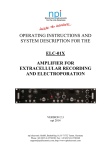
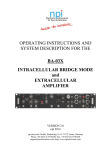
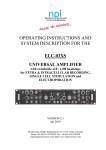
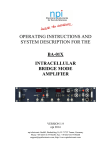

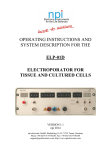


![Jahresbericht 2007 des Fraunhofer IFF [ PDF 3.03 MB ]](http://vs1.manualzilla.com/store/data/006798304_1-2ffbea970edf0c57999fe80b3092fe9a-150x150.png)

